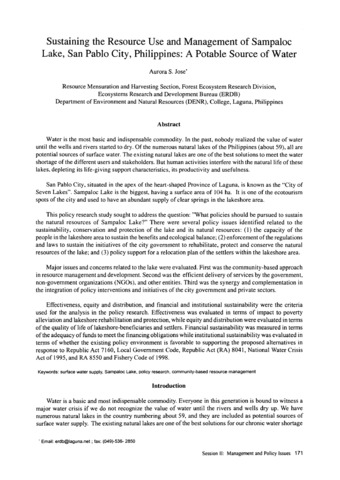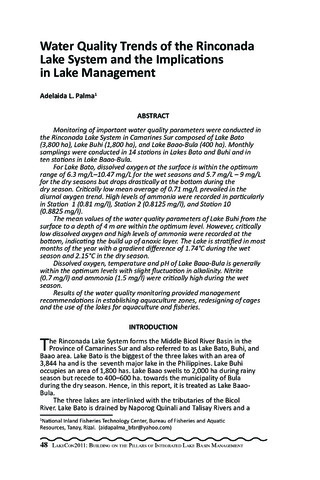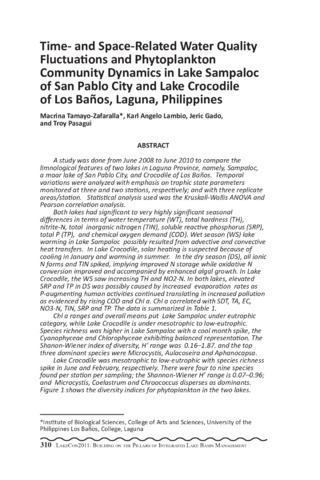Sustaining the resource use and management of Sampaloc Lake, San Pablo City, Philippines: A potable source of water
- Global styles
- MLA
- Vancouver
- Elsevier - Harvard
- APA
- Help

View/
Date
2005Author
Page views
4,241ASFA keyword
AGROVOC keyword
Metadata
Show full item record
Share
Abstract
Water is the most basic and indispensable commodity. In the past, nobody realized the value of water until the wells and rivers started to dry. Of the numerous natural lakes of the Philippines (about 59), all are potential sources of surface water. The existing natural lakes are one of the best solutions to meet the water shortage of the different users and stakeholders. But human activities interfere with the natural life of these lakes, depleting its life-giving support characteristics, its productivity and usefulness.
San Pablo City, situated in the apex of the heart-shaped Province of Laguna, is known as the City of Seven Lakes . Sampaloc Lake is the biggest, having a surface area of 104 ha. It is one of the ecotourism spots of the city and used to have an abundant supply of clear springs in the lakeshore area.
This policy research study sought to address the question: What policies should be pursued to sustain the natural resources of Sampaloc Lake? There were several policy issues identified related to the sustainability, conservation and protection of the lake and its natural resources: (1) the capacity of the people in the lakeshore area to sustain the benefits and ecological balance; (2) enforcement of the regulations and laws to sustain the initiatives of the city government to rehabilitate, protect and conserve the natural resources of the lake; and (3) policy support for a relocation plan of the settlers within the lakeshore area.
Major issues and concerns related to the lake were evaluated. First was the community-based approach in resource management and development. Second was the efficient delivery of services by the government, non-government organizations (NGOs), and other entities. Third was the synergy and complementation in the integration of policy interventions and initiatives of the city government and private sectors.
Effectiveness, equity and distribution, and financial and institutional sustainability were the criteria used for the analysis in the policy research. Effectiveness was evaluated in terms of impact to poverty alleviation and lakeshore rehabilitation and protection, while equity and distribution were evaluated in terms of the quality of life of lakeshore-beneficiaries and settlers. Financial sustainability was measured in terms of the adequacy of funds to meet the financing obligations while institutional sustainability was evaluated in terms of whether the existing policy environment is favorable to supporting the proposed alternatives in response to Republic Act 7160, Local Government Code, Republic Act (RA) 8041, National Water Crisis Act of 1995, and RA 8550 and Fishery Code of 1998.
Suggested Citation
Jose, A. S. (2005). Sustaining the resource use and management of Sampaloc Lake, San Pablo City, Philippines: A potable source of water. In M. L. Cuvin-Aralar, R. S. Punongbayan, A. Santos-Borja, L. V. Castillo, E. V. Manalili, & M. M. Mendoza (Eds.), Proceedings of the First National Congress on Philippine Lakes (pp. 171-178). Southeast Asian Regional Center for Graduate Study and Research in Agriculture (SEARCA).
Type
Conference paperISSN
1656-8099Collections
- LakeCon2003 [49]
Related items
Showing items related by title, author, creator and subject.
-
Series: Summary of Proceedings No. 1/2013;
Water quality trends of the Rinconada lake system and the implications in lake management
Palma, Adelaida L. (PCAARRD-DOST, 2013)Monitoring of important water quality parameters were conducted in the Rinconada Lake System in Camarines Sur composed of Lake Bato (3,800 ha), Lake Buhi (1,800 ha), and Lake Baao-Bula (400 ha). Monthly samplings were ... -
Series: Summary of Proceedings No. 1/2013;
Time- and space-related water quality fluctuations and phytoplankton community dynamics in Lake Sampaloc of San Pablo City and Lake Crocodile of Los Baños, Laguna, Philippines
Tamayo-Zafaralla, Macrina; Lambio, Karl Angelo; Gado, Jeric; Pasagui, Troy (PCAARRD-DOST, 2013)A study was done from June 2008 to June 2010 to compare the limnological features of two lakes in Laguna Province, namely, Sampaloc, a maar lake of San Pablo City, and Crocodile of Los Baños. Temporal variations were ... -
Impact assessment of cage culture in Lake Taal, Philippines
Alcañices, Marilyn M.; Pagulayan, Roberto C.; Mamaril, Augustus C. (Aquaculture Department, Southeast Asian Fisheries Development Center; Philippine Council for Aquatic and Marine Research and Development (PCAMRD), Department of Science and Technology; Bureau of Fisheries and Aquatic Resources, 2001)The environmental impact of cage culture on water quality of Lake Taal was assessed from March 1996 through February 1997. Three stations were considered namely: Balas, which serves as station 1 (non-cage area) and Sampaloc ...




